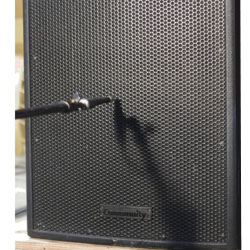
Hearing The Difference
Does 10 Hz of extended LF response make an audible difference? Yes it does. At these low frequencies, gaining another 10 Hz of response is no small thing. The sonic difference between an F3 of 52 Hz versus an F3 of 43 Hz is approximately equal to missing the lowest string on a 4-string bass guitar.
To create the filter shape as seen in the lower trace of Figure 3, you’ll need to combine a peaking filter that’s immediately followed with a high-pass filter below the peaking frequency.
However, it’s important to note that port tuning is also a critical component for optimizing the end result. This is one of several good reasons for using PVC ports if you’re building enclosures yourself. The port depth can easily be adjusted merely by cutting different lengths of PVC tubing. (Do this before committing to gluing the tubes into the enclosure’s baffle board.)
Not all ported loudspeakers react well to a B6 alignment, depending on the interaction of the cone driver’s parameters, the enclosure volume, and the port area and port length.
In all cases, you’ll want to measure the actual acoustic output of the system with a high-resolution FFT analyzer – a 1/3-octave analyzer cannot provide the resolution required for this work.
And though B6 alignments can be predicted by means of various software packages, predictions almost never agree with measured results. Elements such as enclosure shape, driver manufacturing tolerances, barometric pressure, and humidity all can affect the outcome. Even the amount and type of insulation in the enclosure can cause an iso-thermal transfer function that gives the enclosure more apparent interior volume than it actually has (more insulation = more apparent volume). Therefore, actual measurement is the only way to truly know what’s happening.
A small number of DSP devices, such as the recently introduced Community dSPEC, offer “under-damped” filters. Properly adjusted, an under-damped filter can perform both functions: that of providing the LF peak and the high-pass roll-off. But if your DSP doesn’t offer an under-damped filter, then you’ll need to use a parametric equalizer (PEQ) to generate the peak, and a high-pass filter immediately below the peak. The high-pass filter should be at least 12 dB/octave, but 24 dB/octave (technically a B8 alignment) or a higher order is recommended.
Because the high-pass filter will have a strong effect on the actual (and measured) amplitude of the peaking filter, you’ll find that the peaking filter may have to be set to +12 dB, or even to the full extent of its range (which is usually +15 dB) in order to produce the desired +6 dB peak that forms the basis of the B6 alignment. In fact, the only reason not to use a higher order high-pass filter, such as 36 dB/octave or even 48 dB/octave, is that the peaking filter probably can’t provide enough amplitude to compensate for the effect of the adjacent high-pass filter whose upper “skirt” will be overlapping the lower skirt of the peaking filter.
Two peaking filters of the same center frequency and Q can be “ganged together” to provide greater overall amplitude, but you’ll need to be careful not to exceed internal DSP limitations, which can result in distortion or other undesirable behavior.
In most loudspeakers, a B6 (or higher order) alignment usually can be implemented with stable driver behavior and improved sonic quality. However, you’ll want to thoroughly test the results under low levels, moderate levels, and very high levels to be sure you’re obtaining a net improvement. If the filters are in the right place, the result will always reflect a lower F3 cutoff point, and usually a marked improvement in LF definition. The newly aligned loudspeaker will give you a well-defined bandwidth, making it easier to integrate it into a multi-zone system, or into an array formation.
Filters & Dynamics
While protective limiters are an important element in avoiding both catastrophic failure and enhancing longevity of loudspeakers, the first line of defense should always be the use of low-pass and high-pass filters. Using a B6 (or higher) alignment inherently applies a sharp high-pass filter. While the high-pass may only be second-order (12 dB/octave), because the high-pass is stacked on the low side of the adjacent peaking filter, it will measure at a rate of about 18 dB/octave. If you use a higher order high-pass filter, the rejection of low frequency energy to the driver will be even greater.
The net effect is that the cone driver will be working well within its range of efficient reproduction, rather than trying to reproduce frequencies that are lower than practical. This also means that the amplifier is not wasting power trying to reproduce LF information that’s not going to transfer efficiently – or even be perceptible – into acoustic energy. Everyone wins.
An additional protection possibility is to assign a “dynamic protective limiter” to the B6 alignment LF peaking filter. If your DSP unit permits this (and the well-designed XTA DP548 indeed does), then, as the driver begins to approach its excursion limit, the protective limiter will reduce the amplitude of the B6 peaking filter.
In actual practice, it’s hard to determine if this form of driver protection is engaged or not. When the threshold is properly set, the cone driver will be on the verge of becoming non-linear anyway, so given the lesser of two evils, a soft reduction in the peaking filter amplitude will provide a very subtle means of keeping the driver healthy, while not being obvious to the listener.
